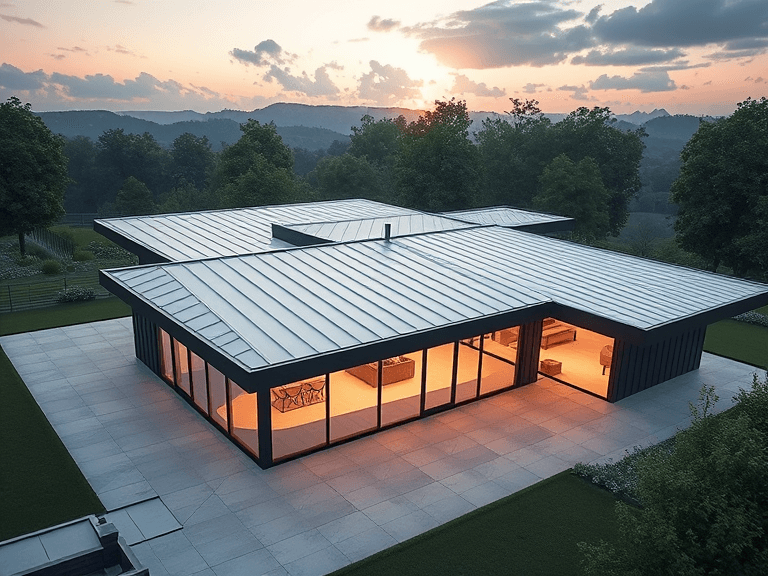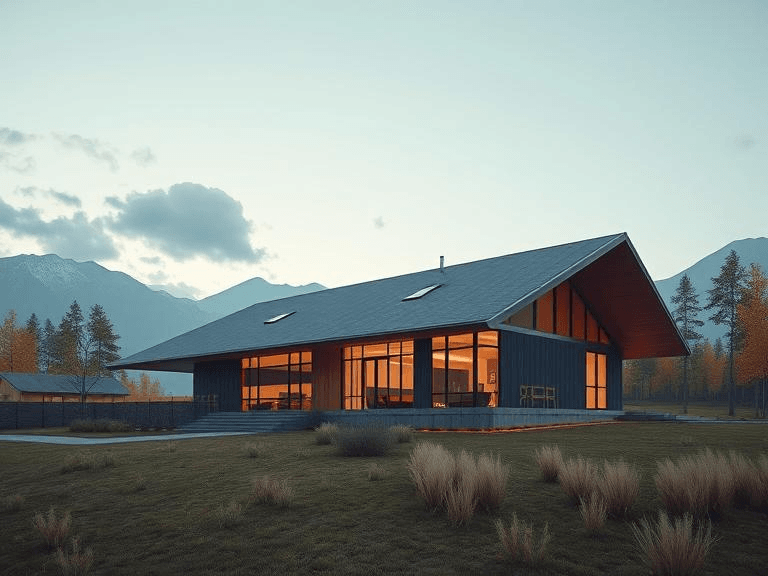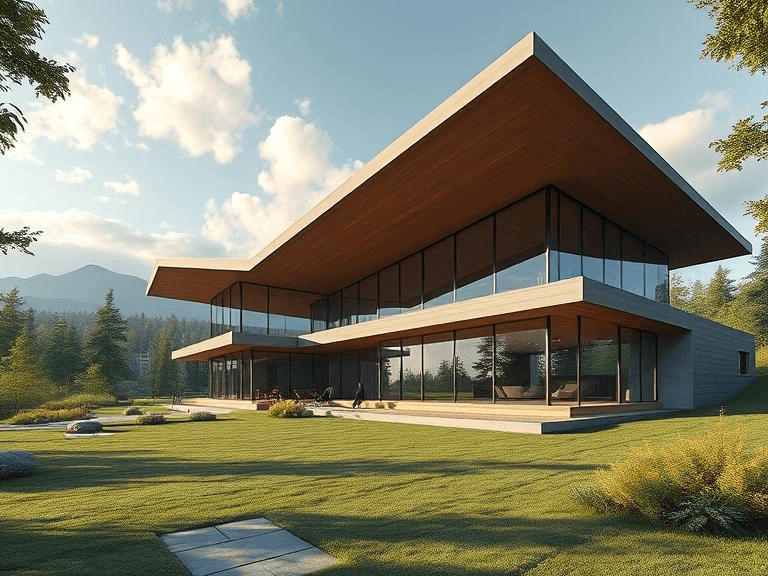
Flat metal roofing has emerged as a significant innovation in the construction industry, gaining traction for both residential and commercial buildings. This roofing system is characterized by its sleek, contemporary appearance and unmatched durability, making it an attractive choice for property owners. One of the primary materials used in flat metal roofing systems includes aluminum, which offers lightweight yet robust characteristics, alongside options such as steel and copper, each providing distinct benefits and aesthetics.
The increasing popularity of flat metal roofs can be attributed to their myriad advantages. These roofing systems are renowned for their longevity, with many flat metal roofs boasting lifespans exceeding 50 years with proper maintenance. Additionally, they often require less maintenance compared to traditional roofing types, making them a cost-effective solution in the long run. Energy efficiency is another crucial factor contributing to the appeal of flat metal roofing. By reflecting solar heat, these roofs can significantly reduce cooling costs, providing considerable savings for homeowners and businesses alike.
In modern construction, flat metal roofing is also recognized for its environmentally friendly attributes. Many manufacturers produce metal roofing from recycled materials and promote its recyclability at the end of its life cycle. Furthermore, flat metal roofs can accommodate green building practices by allowing for easy installation of solar panels and roofing gardens. With such advantages, flat metal roofing stands out as the ultimate solution in the evolving landscape of roofing options, meeting the demands for both aesthetics and performance in today’s sustainable development practices.
Benefits of Flat Metal Roofing
Flat metal roofing has emerged as a preferred choice for many homeowners and commercial property owners due to its numerous advantages. One significant benefit is its durability. Unlike traditional roofing materials, flat metal roofing can withstand extreme weather conditions, including high winds, heavy snow, and intense sunlight. It is resistant to pests and does not decay or rot, which ensures a longer lifespan when compared to asphalt shingles or wooden roofing options. Thus, investing in flat metal roofing can lead to substantial savings in the long run, as the need for repairs and replacements is significantly minimized.
Another critical aspect of flat metal roofing is its energy efficiency. Metal roofs reflect solar heat, reducing the amount of heat absorbed into the building. This property leads to decreased reliance on air conditioning systems, particularly during the warm summer months, contributing to lower energy bills. This energy efficiency is not only environmentally friendly but also aligns with the increasing demand for sustainable building materials. Moreover, many manufacturers offer energy-efficient metal roofing options that contain reflective pigments, further enhancing their ability to maintain cooler indoor environments.
Low maintenance requirements add to the appeal of flat metal roofing. Traditional roofs require regular inspections, cleaning, and repairs to ensure longevity. In contrast, flat metal roofs demand minimal upkeep, with periodic checks being sufficient to maintain their integrity. The seamless design of flat metal roofing mitigates issues associated with leaks and water pooling, often seen with other roofing types. With such an array of benefits, flat metal roofing presents a compelling case against conventional options, offering a modern, practical solution that meets the needs of both residential and commercial properties.
Types of Flat Metal Roofing Systems
Flat metal roofing systems have gained popularity due to their durability, low maintenance requirements, and modern aesthetic appeal. Within this category, several types of systems are available, each with unique features and applications tailored to various building requirements.
One widely used type is the standing seam metal roof. This system is characterized by interlocking panels that run vertically from the ridge to the eaves. The seams, which stand above the roofing surface, provide excellent protection against water infiltration and are typically crafted from steel, aluminum, or copper. Standing seam roofs are particularly favored for commercial buildings and areas with heavy rainfall due to their superior performance and long lifespan, often exceeding twenty years with proper maintenance.
Another option is flat panels, which offer a sleek, minimalist look. These panels can be made from various materials, including aluminum, steel, or zinc, and are generally installed with a flat surface appearance. Flat panels are commonly used in residential applications and lightweight structures, benefiting from a lower profile and a straightforward installation process. They can be customized with various colors and finishes, making them an appealing choice for homeowners seeking aesthetic versatility.
Lastly, the corrugated metal roofing system is recognized for its distinctive ribbed appearance. This type of flat metal roofing is renowned for its strength and lightweight nature, making it suitable for agricultural buildings, storage facilities, and workshops. The corrugated profile allows for effective water runoff and aids in energy efficiency due to its ability to reflect sunlight.
Each of these flat metal roofing systems provides distinct advantages, allowing property owners to select the best option based on specific climate conditions, budget constraints, and architectural design. By evaluating the characteristics and capabilities of standing seam roofs, flat panels, and corrugated metal options, individuals can make informed decisions regarding flat metal roofing as the ultimate solution for their needs.

Installation Process of Flat Metal Roofing
The installation of flat metal roofing systems is a detailed process requiring careful planning and execution to ensure durability and effectiveness. The first step involves site preparation, which is crucial for creating a solid foundation for the roofing material. This includes removing any existing roofing materials, ensuring a clean and level surface, and repairing any structural issues that may be present. Proper preparation not only enhances the lifespan of the new roof but also facilitates a smoother installation.
Next, gathering the necessary tools is essential to ensure a seamless installation. Common tools utilized in the process include a metal shear, a drill, a measuring tape, a level, and safety equipment such as a hard hat and harness. The selected metal sheets, typically aluminum or steel, should be cut to fit the designated area; accurate measurements are critical to avoid wastage and ensure efficiency. Additionally, ensuring all tools are readily available before commencing work can significantly decrease delays during the installation phase.
Safety is paramount throughout the entire installation process of flat metal roofing. Contractors must adhere to safety regulations and use the appropriate personal protective equipment (PPE). This includes gloves, eye protection, and harnesses to prevent falls from height. Furthermore, it is advisable to conduct weather assessments prior to installation to avoid complications associated with adverse conditions. Following each step diligently ensures not only the safety of the workers but also the quality of the completed roofing system.
In conclusion, the installation process for flat metal roofing systems is comprehensive, consisting of preparation, tool selection, and safety adherence. Property owners should expect a meticulous approach that ultimately results in a robust roofing solution that effectively protects their investment for years to come.
Cost Analysis: Flat Metal Roofing vs. Traditional Roofing
When evaluating roofing options, understanding the cost implications of flat metal roofing compared to traditional roofing materials such as asphalt shingles or clay tiles is critical. Initially, flat metal roofing may have a higher upfront cost, often ranging from $4 to $9 per square foot, depending on the type of metal used and local labor rates. In contrast, traditional asphalt shingles tend to cost between $1.50 and $4 per square foot. This disparity in initial costs can be a significant factor for homeowners or business owners considering a roofing system.
While flat metal roofing may require a larger investment initially, it is essential to consider the long-term savings associated with its durability and low maintenance needs. Metal roofs can last 40 to 70 years, whereas traditional roofing typically requires replacement every 15 to 30 years. This longevity means that while the upfront costs are more substantial, the overall lifecycle cost can be more favorable for flat metal roofing, resulting in decreased need for replacement and repairs over time.
Moreover, flat metal roofing is renowned for its energy efficiency. It reflects solar energy, which can lead to lower cooling costs in warmer climates. According to recent studies, homeowners can save as much as 20% on energy costs with a reflective metal roof versus traditional roofing options. Such energy savings, combined with the minimal maintenance required for metal roofs—such as occasional cleaning—can contribute to a lower total cost of ownership over time.
In conclusion, while the upfront costs of flat metal roofing may be higher than those of traditional roofing materials, its durability, energy efficiency, and low long-term maintenance needs present a compelling financial case for choosing flat metal roofing as the ultimate solution for roofing needs. Evaluating both initial and ongoing costs will help guide an informed decision on the most cost-effective option for home or business roofing projects.
Maintenance Tips for Flat Metal Roofing
Maintaining flat metal roofing is essential to ensure its longevity and performance. Regular inspections play a critical role in identifying potential issues before they escalate into costly repairs. It is advisable to conduct thorough inspections at least twice a year, ideally in the spring and fall. During these inspections, look for signs of wear such as rust, loose seams, or any visible damage. Pay special attention to the areas around roof penetrations and flashings, as these are common points where leaks may develop.
Cleaning the roof is another vital aspect of maintenance. Debris such as leaves and branches can accumulate on flat metal surfaces, leading to moisture retention and, eventually, corrosion. To maintain the integrity of your roof, perform regular cleanings, ideally after heavy storms or seasonal changes. Use a soft-bristle broom or blower to clear debris without scratching the metal surface, and wash with a mild detergent solution to eliminate dirt and grime. Rinse thoroughly to prevent any residue from causing damage over time.
For any repairs, it is crucial to use materials compatible with your specific type of metal roofing. Patch any holes or damage promptly with appropriate sealant or metal flashing. If extensive damage occurs, consider consulting a professional to assess and address the repairs effectively. Additionally, examine the roof’s drainage system to ensure that gutters and downspouts are functioning correctly. Blocked drainage can lead to water pooling, which can deteriorate flat metal roofing if not managed appropriately.
In conclusion, regular maintenance of flat metal roofing, including inspections, cleaning, and timely repairs, is simple yet critical for extending its lifespan. By adopting these maintenance tips, homeowners can enjoy the long-lasting benefits that flat metal roofs offer, ensuring optimal performance throughout the years.
Environmental Impact of Flat Metal Roofing
Flat metal roofing has gained popularity not only for its structural benefits but also for its positive environmental impact. Many homeowners and builders are increasingly drawn to this roofing solution due to its recyclability, energy efficiency, and the ability to support solar panel installations. These attributes collectively contribute to the promotion of sustainable building practices.
One of the foremost advantages of flat metal roofing is its recyclability. Unlike traditional roofing materials, which may end up in landfills, metal roofs can be recycled at the end of their life cycle. Typically made from materials such as aluminum or steel, flat metal roofing is not only durable and long-lasting, but it can also be repurposed, significantly reducing the environmental footprint associated with its installation and eventual replacement. This closed-loop system helps conserve natural resources and minimizes waste.
Additionally, flat metal roofing offers remarkable energy efficiency. The reflective nature of metal surfaces can reduce heat absorption and, consequently, the demand for air conditioning in warmer months. Studies indicate that metal roofs can lower energy costs by reflecting a significant percentage of solar radiation. Consequently, the adoption of flat metal roofing can lead to reduced greenhouse gas emissions, as it diminishes energy consumption in residential and commercial buildings.
Moreover, flat metal roofs create an ideal platform for solar panel installation. Their structural integrity and accessibility enable homeowners to harness solar energy effectively, contributing to further energy savings and a decrease in reliance on fossil fuels. By integrating renewable energy systems, flat metal roofing not only allows for sustainable living but also encourages a shift toward greener building practices. Overall, choosing flat metal roofing presents a multitude of environmental benefits that make it a forward-thinking choice in modern construction.
Influence of Weather on Flat Metal Roofing
Flat metal roofing has gained significant popularity due to its durability and long-lasting performance in various weather conditions. However, the effectiveness of this roofing system can be influenced by different climatic factors, including temperature fluctuations, precipitation, and snow accumulation. Understanding how these elements affect flat metal roofing can aid in making informed decisions regarding its installation and maintenance.
In regions that experience extreme temperatures, flat metal roofing demonstrates commendable resistance. Metal roofs can endure both intense heat and frigid cold. The material’s reflective properties help to dissipate heat, which keeps indoor temperatures stable in hot climates. Conversely, in colder regions, the insulation properties of some flat metal roofing systems can help to minimize heat loss. However, it is essential to use appropriate materials and design strategies to combat thermal expansion and contraction, which can lead to structural stress over time.
Furthermore, heavy snowfall poses a unique challenge for flat roofing systems. Unlike pitched roofs, flat metal roofing relies on proper drainage solutions to handle snow loads effectively. Accumulation of snow can lead to increased weight, potentially stressing the structure. Therefore, it is critical to design these roofing systems with adequate slope and drainage systems to facilitate water runoff and reduce the risk of ice dam formation. Additionally, flat metal roofing is generally resistant to water leaks compared to other roofing types, provided that seams are adequately sealed.
Heavy rainfalls also require consideration, as flat metal roofing can face potential drainage issues. The design must include appropriate gutter systems to prevent water pooling, which, if unaddressed, could lead to leaks or structural damage. Regular maintenance checks, especially after severe weather events, can help mitigate these risks, ensuring that flat metal roofing remains a reliable choice across a range of climates.
Conclusion: Is Flat Metal Roofing Right for You?
As we have explored throughout this article, flat metal roofing presents numerous advantages that make it a noteworthy option for both residential and commercial applications. The durability, low maintenance requirements, and energy efficiency of flat metal roofing are compelling reasons to consider this roofing solution. It effectively stands up to various weather conditions, contributes to energy savings through reflective properties, and requires less frequent repairs, thereby offering long-term financial benefits.
To determine if flat metal roofing is the ultimate solution for your specific needs, several factors should be considered. First, assess your local climate. Flat metal roofing is particularly effective in areas prone to heavy rain or snow, as it facilitates efficient drainage. Similarly, regions with high temperatures may benefit from metal roofing’s reflective qualities, which can contribute to a cooler indoor environment. Additionally, potential buyers should carefully examine the architectural style of their home or building. Metal roofs are versatile and can be adapted, yet they often align best with modern and contemporary designs.
Furthermore, understanding the installation process and required maintenance is crucial. Although installation may require skilled labor, the longevity of flat metal roofing often offsets these upfront costs. Evaluate your budget and consider long-term savings gained from reduced energy costs and maintenance. It is also beneficial to seek professional advice from roofing contractors who can provide tailored recommendations based on your circumstances.
In conclusion, flat metal roofing is not only an aesthetically pleasing choice but also a practical one. It provides a blend of durability, efficiency, and cost-effectiveness that can meet a variety of roofing needs. By taking into account the unique aspects of your project, you can make an informed decision on whether flat metal roofing truly is the ultimate solution for you.


